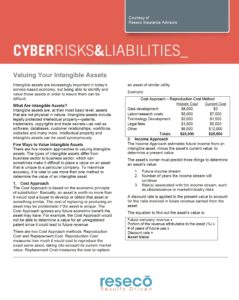Intangible assets are increasingly important in today’s service-based economy, but being able to identify and value those assets in order to insure them can be difficult.
What Are Intangible Assets?
Intangible assets are, at their most basic level, assets that are not physical in nature. Intangible assets include legally protected intellectual property—patents, trademarks, copyrights and trade secrets—as well as software, databases, customer relationships, workforce, websites, and many more. Intellectual property and intangible assets can be used synonymously.
Five Ways to Value Intangible Assets
There are five modern approaches to valuing intangible assets. The types of intangible assets differ from business sector to business sector, which can sometimes make it difficult to place a value on an asset
that is unique to a particular company. To maximize accuracy, it is wise to use more than one method to determine the value of an intangible asset.
1. Cost Approach
The Cost Approach is based on the economic principle of substitution. Basically, an asset is worth no more than it would cost a buyer to develop or obtain that asset or something similar. The cost of replacing or producing an asset may be problematic if the asset is unique. The Cost Approach ignores any future economic benefit the asset may have. For example, the Cost Approach would not be able to determine a value for an unregistered patent since it could lead to future revenue.
There are two Cost Approach methods: Reproduction Cost and Replacement Cost. Reproduction Cost measures how much it would cost to reproduce the exact same asset, taking into account its current market value. Replacement Cost measures the cost to replace an asset of similar utility.

Download the complete “Cyber Liability Valuing Your Intangible Assets” – pdf

